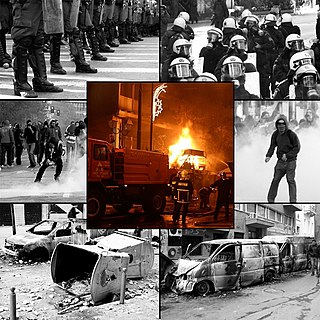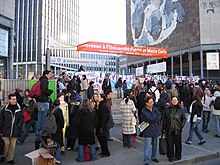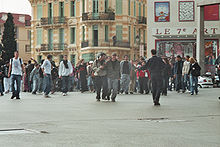
The 1967 Hong Kong riots were large-scale anti-government riots that occurred in Hong Kong during British colonial rule. Beginning as a minor labour dispute, the demonstrations eventually escalated into protests against the colonial government. The protests were partially inspired by successful anti-colonial demonstrations in Portuguese Macau which had occurred a few months prior.

Ungdomshuset was the popular name of the building formally named Folkets Hus located on Jagtvej 69 in Nørrebro, Copenhagen, which functioned as an underground scene venue for music and rendezvous point for varying autonomist and leftist groups from 1982 until 2007 when—after prolonged conflict—it was torn down, and later also for its successor, located on Dortheavej 61 in the adjacent Bispebjerg neighbourhood. Due to the ongoing conflict between the Copenhagen Municipality and the activists occupying the premises, the building on Jagtvej was the subject of intense media attention and public debate from the mid-1990s till 2008.

The contrat première embauche was a new form of employment contract pushed in spring 2006 in France by Prime Minister Dominique de Villepin. This employment contract, available solely to employees under 26, would have made it easier for the employer to fire employees by removing the need to provide reasons for dismissal for an initial "trial period" of two years, in exchange for some financial guarantees for employees, the intention being to make employers less reluctant to hire additional staff. However, the enactment of this amendment to the so-called "Equality of Opportunity Act" establishing this contract was so unpopular that soon massive protests were held, mostly by young students, and the government rescinded the amendment.
A contrat nouvelle embauche, known as a new employment contract, new recruitment contract or new-job contract in English is a French employment contract proposed by Prime Minister Dominique de Villepin (UMP) which came into force by ordinance on August 2, 2010. The measure was enacted by the prime minister after he was authorized by Parliament to take legislative measures to stimulate employment. Unlike the later First Employment Contract (CPE) which was repealed in 2010, after protests the CNE has been used as a job contract despite opposition from trade unions.

The May Thirtieth Movement was a major labor and anti-imperialist movement during the middle-period of the Republic of China era. It began when the Shanghai Municipal Police opened fire on Chinese protesters in Shanghai's International Settlement on May 30, 1925. The shootings sparked international censure and nationwide anti-foreign demonstrations and riots.
Sein Lwin was a Burmese politician and retired military general in the Myanmar Army. He was served as the sixth president of Burma for 17 days in 1988, following the resignation of San Yu.

The 2008 Greek riots started on 6 December 2008, when Alexandros Grigoropoulos, a 15-year-old Greek student, was killed by a special officer in Exarcheia district of central Athens. The killing of the young student by police resulted in large protests and demonstrations, which escalated to widespread rioting, with numerous rioters damaging property and engaging riot police with Molotov cocktails, stones and other objects. Demonstrations and rioting soon spread to several other cities, including Thessaloniki, the country's second-largest city, and international cities in solidarity. Newspaper Kathimerini called the rioting "the worst Greece has seen since the restoration of democracy in 1974".
The 2009 May Day protests were a series of international protests that took place across Europe, Asia and in the other parts of the world due to the financial crisis of 2007–2008 and the resulting Great Recession. Several May Day marches, which are traditional events, had turned violent in Germany, Turkey and Venezuela as riot police battled protesters in their respective countries. Banks and shops had been attacked in Turkey.

The 1982 demonstrations in Poland refers to anti-government street demonstrations organized by underground Solidarity to commemorate the second anniversary of the Gdańsk Agreement. The bloodiest protest occurred in southwestern Poland, in the town of Lubin, on August 31, 1982. The Lubin demonstration resulted in three protesters killed by Communist services, and an unknown number of wounded. On the same day, rallies and demonstrations took place in several cities across the country. According to Solidarity sources, there were four more victims—in Wrocław, Gdańsk, Nowa Huta, and Toruń. According to official government sources, there were demonstrations in 66 cities.
The word serhildan describes several Kurdish protests and uprisings since the 1990s that used the slogan "Êdî Bese" ("Enough") against Turkey. Local shops are often closed on the day of demonstrations as a form of protest.
French labour law is the system of labour law operating in France.

The 2010 United Kingdom student protests were a series of demonstrations in November and December 2010 that took place in several areas of the country, with the focal point of protests being in central London. Largely student-led, the protests were held in opposition to planned spending cuts to further education and an increase of the cap on tuition fees by the Conservative–Liberal Democrat coalition government following their review into higher education funding in England. Student groups said that the intended cuts to education were excessive, would damage higher education, give students higher debts, and broke campaign promises made by politicians.
This is a list of crises situations and major protests in countries of Europe since the year 2000.

The 2010–2012 Algerian protests were a series of protests taking place throughout Algeria, lasting from 28 December 2010 to early 2012. The protests had been inspired by similar protests across the Middle East and North Africa. Causes cited by the protesters included unemployment, the lack of housing, food-price inflation, corruption, restrictions on freedom of speech and poor living conditions. While localized protests were already commonplace over previous years, extending into December 2010, an unprecedented wave of simultaneous protests and riots, sparked by sudden rises in staple food prices, erupted all over the country starting in January 2011. These were quelled by government measures to lower food prices, but were followed by a wave of self-immolations, most of them in front of government buildings. Opposition parties, unions, and human rights organisations then began to hold weekly demonstrations, despite these being illegal without government permission under the ongoing state of emergency; the government suppressed these demonstrations as far as possible, but in late February yielded to pressure and lifted the state of emergency. Meanwhile, protests by unemployed youth, typically citing unemployment, hogra (oppression), and infrastructure problems, resumed, occurring almost daily in towns scattered all over the country.

The Corpus Christi Massacre or El Halconazo was a massacre of student demonstrators during the Mexican Dirty War in Mexico City on 10 June 1971, the day of the Corpus Christi festival. Nearly 120 protesters were killed, among them a 14-year-old boy.

The UC Davis pepper spray incident occurred on November 18, 2011, during an Occupy movement demonstration at the University of California, Davis. After asking the protesters to leave several times, university police pepper sprayed a group of student demonstrators as they were seated on a paved path in the campus quad. The video of UC Davis police officer Lt. John Pike pepper-spraying demonstrators spread around the world as a viral video and the photograph became an Internet meme. Officer Alex Lee also pepper sprayed demonstrators at Pike's direction.

The 2012 Quebec student protests (movement) were a series of student protests led by students individually such as the Association pour une solidarité syndicale étudiante (ASSÉ), the Fédération étudiante universitaire du Québec, and the Fédération étudiante collégiale du Québec against a proposal by the Quebec Cabinet, headed by Liberal Premier Jean Charest, to raise university tuition from $2,168 to $3,793 between 2012 and 2018. As part of the protest movement, a series of widespread student strikes were organized, involving half of Quebec's student population by April 2012. A third of Québécois students continued to participate in the strike by its 100th day, while a quarter million had participated during its peak. Other students continued to attend their courses.

Since Emmanuel Macron was elected President of France on 7 May 2017, a series of protests have been conducted by trade union activists, left-wing activists and right-wing activists in opposition to what protesters consider to be neoliberal policies and globalism, his support of state visits by certain world leaders, his positions on French labour law reform, as well as various comments or policy proposals he has made since assuming the presidency.

The sentencing of nine Catalan independence leaders in a 2019 trial by the Supreme Court of Spain triggered protests in Catalonia. They were convicted of sedition and other crimes against the Spanish state for their role in the organization of the 2017 Catalan independence referendum.
The 1986–1987 protests in France is mass protests and a political movement that erupted after a new law signed by the government in November 1986, named the Devaquet law, sparking mass student protests and Strikes across France from 28 November 1986 – 11 January 1987. Riots and looting occurred throughout the city of Paris but spread to 3 other cities.

















